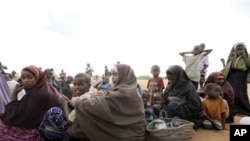The World Health Organization reports about two million people in Somalia, or nearly one-third of the total population, are in need of humanitarian assistance. That includes almost 1.5 million internally displaced people.
Somalia has been in a chronic state of emergency for almost 20 years. It has had no effective central government since the country's last dictator, Siad Barre, was overthrown in a coup in 1991.
Since then, the country has been lurching from one crisis to another. Conflict among rival groups is a permanent part of the scene. All this is taking a terrible toll on the health and wellbeing of the Somali people.
WHO Representative in Somalia, Marthe Everard, says three hospitals in the capital Mogadishu report more than 7,000 people have been injured since the beginning of this year. She says these injuries include one in five children and one in three women.
In addition, she says WHO estimates more than 500 people have been killed due to the intensified conflict and military interventions.
"The problem is that we cannot give you an exact figure on the deaths because many people who die in an event will not come to the hospital and there also is not a registration system for death certificates," said Everard. "So, what is coming to the hospitals, that is what we can report on."
Related report by Mike Sunderland:
The World Health Organization reports mothers and newborns in Somalia suffer from alarming levels of death and disease. It notes one in five children die before the age of five and the maternal mortality rate also is very high.
It says Somalia has a very weak health workforce. This is the result of a severe brain drain of skilled health workers who go to work in high-income foreign countries. Currently, Somalia only has around 250 qualified doctors, 860 nurses and just 116 midwives.
Insecurity is making it very difficult for health and other aid workers to get access to certain parts of the country. In January, growing insecurity and threats from the militant al-Shabab forced the World Food Program to leave South Central Somalia, depriving hundreds of thousands of needy people of food.
Despite these and other problems, Dr. Everard says the World Health Organization is wracking up a number of successes. For instance, she says Somalia has been polio-free since 2007. She says more than 40 tuberculosis clinics with trained staff are operating in south-central Somalia and malaria control programs are saving lives.
"The perception is that nothing can be done in Somalia," said Dr. Everard. "But, with communities, the communities in Somalia are there also to work and to support the health issues. So, the community structure is very strong and they sometimes say we need bed nets, we need this, we need education interventions. So, please come and help us. They are very vocal and they are very structured-maybe because of the clan system, so that they can make a voice altogether."
The United Nations is appealing for $530 million for urgent humanitarian needs in Somalia next year. The so-called health cluster requires nearly $60 million of that sum to fund 45 life-saving health projects.
These include extending emergency care, including maternal and reproductive health, outbreak control and supporting key hospitals throughout the country.












